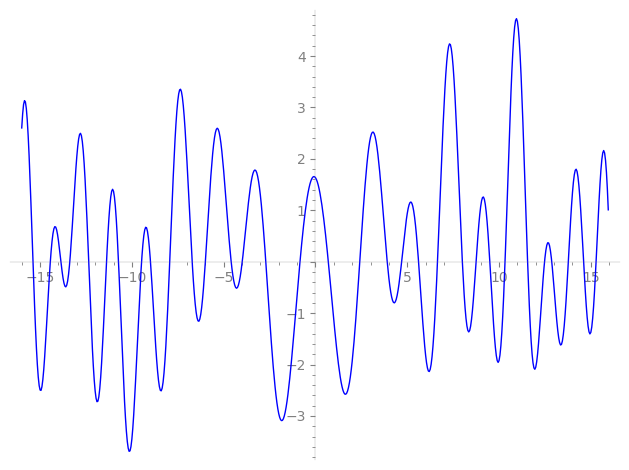| L(s) = 1 | + 0.945·2-s − 7.10·4-s + 5i·5-s − 8.03i·7-s − 14.2·8-s + 4.72i·10-s + (20.9 − 29.8i)11-s + 41.3i·13-s − 7.59i·14-s + 43.3·16-s − 92.7·17-s − 37.2i·19-s − 35.5i·20-s + (19.8 − 28.2i)22-s + 32.4i·23-s + ⋯ |
| L(s) = 1 | + 0.334·2-s − 0.888·4-s + 0.447i·5-s − 0.433i·7-s − 0.631·8-s + 0.149i·10-s + (0.575 − 0.817i)11-s + 0.882i·13-s − 0.145i·14-s + 0.677·16-s − 1.32·17-s − 0.449i·19-s − 0.397i·20-s + (0.192 − 0.273i)22-s + 0.293i·23-s + ⋯ |
\[\begin{aligned}\Lambda(s)=\mathstrut & 495 ^{s/2} \, \Gamma_{\C}(s) \, L(s)\cr =\mathstrut & (0.942 - 0.335i)\, \overline{\Lambda}(4-s) \end{aligned}\]
\[\begin{aligned}\Lambda(s)=\mathstrut & 495 ^{s/2} \, \Gamma_{\C}(s+3/2) \, L(s)\cr =\mathstrut & (0.942 - 0.335i)\, \overline{\Lambda}(1-s) \end{aligned}\]
Particular Values
| \(L(2)\) |
\(\approx\) |
\(1.635075179\) |
| \(L(\frac12)\) |
\(\approx\) |
\(1.635075179\) |
| \(L(\frac{5}{2})\) |
|
not available |
| \(L(1)\) |
|
not available |
\(L(s) = \displaystyle \prod_{p} F_p(p^{-s})^{-1} \)
| $p$ | $F_p(T)$ |
|---|
| bad | 3 | \( 1 \) |
| 5 | \( 1 - 5iT \) |
| 11 | \( 1 + (-20.9 + 29.8i)T \) |
| good | 2 | \( 1 - 0.945T + 8T^{2} \) |
| 7 | \( 1 + 8.03iT - 343T^{2} \) |
| 13 | \( 1 - 41.3iT - 2.19e3T^{2} \) |
| 17 | \( 1 + 92.7T + 4.91e3T^{2} \) |
| 19 | \( 1 + 37.2iT - 6.85e3T^{2} \) |
| 23 | \( 1 - 32.4iT - 1.21e4T^{2} \) |
| 29 | \( 1 - 137.T + 2.43e4T^{2} \) |
| 31 | \( 1 - 91.1T + 2.97e4T^{2} \) |
| 37 | \( 1 - 157.T + 5.06e4T^{2} \) |
| 41 | \( 1 - 512.T + 6.89e4T^{2} \) |
| 43 | \( 1 - 181. iT - 7.95e4T^{2} \) |
| 47 | \( 1 - 245. iT - 1.03e5T^{2} \) |
| 53 | \( 1 - 372. iT - 1.48e5T^{2} \) |
| 59 | \( 1 - 826. iT - 2.05e5T^{2} \) |
| 61 | \( 1 + 717. iT - 2.26e5T^{2} \) |
| 67 | \( 1 - 937.T + 3.00e5T^{2} \) |
| 71 | \( 1 - 84.9iT - 3.57e5T^{2} \) |
| 73 | \( 1 + 938. iT - 3.89e5T^{2} \) |
| 79 | \( 1 - 486. iT - 4.93e5T^{2} \) |
| 83 | \( 1 - 890.T + 5.71e5T^{2} \) |
| 89 | \( 1 - 226. iT - 7.04e5T^{2} \) |
| 97 | \( 1 + 274.T + 9.12e5T^{2} \) |
| show more | |
| show less | |
\(L(s) = \displaystyle\prod_p \ \prod_{j=1}^{2} (1 - \alpha_{j,p}\, p^{-s})^{-1}\)
Imaginary part of the first few zeros on the critical line
−10.72897655376312051841528445986, −9.471452328098201127888474058680, −8.986797537501075461854177198406, −7.939259197742456084029873146751, −6.71542975463443925524840222995, −5.99745387900187598660534162380, −4.59111912554881051562301858027, −3.98821950744414360850618227517, −2.70506457372598210972425770498, −0.842239469282132435963246626458,
0.70009189157356842830858383266, 2.41278152353692445045759591213, 3.90850508536798501908050792437, 4.69356736856473403178696736249, 5.61602530373978210027545461472, 6.64677251036482992963076504109, 8.001369734230359507013612373532, 8.749606726680351753229604847778, 9.497604803155093969764866500664, 10.32669402216415465483826577176

